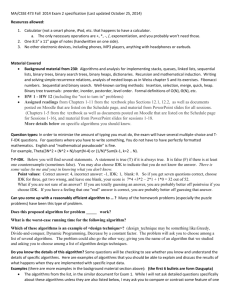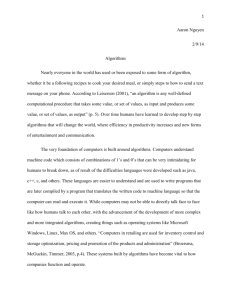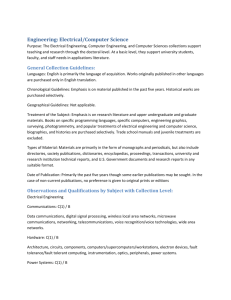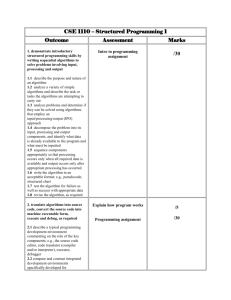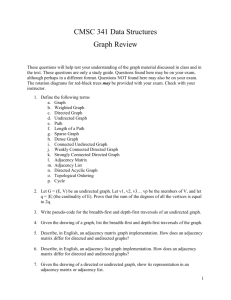University of Cebu CICS Portal
advertisement
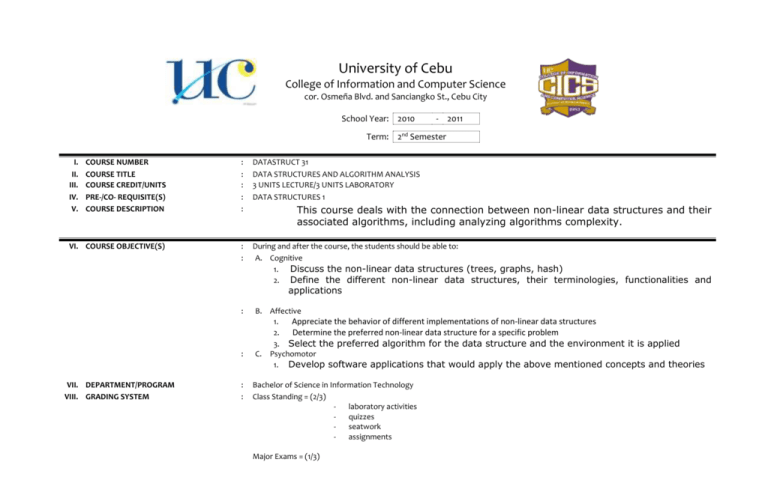
University of Cebu College of Information and Computer Science cor. Osmeña Blvd. and Sanciangko St., Cebu City School Year: 2010 - 2011 Term: 2nd Semester I. II. III. IV. V. COURSE NUMBER COURSE TITLE COURSE CREDIT/UNITS PRE-/CO- REQUISITE(S) COURSE DESCRIPTION : : : : : DATASTRUCT 31 DATA STRUCTURES AND ALGORITHM ANALYSIS 3 UNITS LECTURE/3 UNITS LABORATORY DATA STRUCTURES 1 VI. COURSE OBJECTIVE(S) : : During and after the course, the students should be able to: A. Cognitive 1. Discuss the non-linear data structures (trees, graphs, hash) 2. Define the different non-linear data structures, their terminologies, functionalities and This course deals with the connection between non-linear data structures and their associated algorithms, including analyzing algorithms complexity. applications : : VII. DEPARTMENT/PROGRAM VIII. GRADING SYSTEM : : B. Affective 1. Appreciate the behavior of different implementations of non-linear data structures 2. Determine the preferred non-linear data structure for a specific problem 3. Select the preferred algorithm for the data structure and the environment it is applied C. Psychomotor 1. Develop software applications that would apply the above mentioned concepts and theories Bachelor of Science in Information Technology Class Standing = (2/3) laboratory activities quizzes seatwork assignments Major Exams = (1/3) IX. COURSE OUTLINE AND TIMEFRAME : To review the linear data structures 30 hours To discuss binary tree data structure 30 hours To explain the different Graph Traversals 30 hours Introduce of Hashing 30 hours Prelim Specific Objectives 1. To review the linear data structures 2. To be able to compute the time it takes to run an algorithms 3. To recognize the value of memory space efficiency of a program 4 . To demonstrate selected search algorithms 5. To explain selected sorting algorithms Topics/Course Content 1. Review on a. List b. Stack c. Queue d. Set 2. Complexities on Algorithm a. Mathematical formula b. Big-Oh notation c. Big-Omega notation d. Big-Theta notation 3. Introduce recursion 4. Selected Search Algorithms a. Sequential search b. Binary search 5. Selected Sorting Algorithms a. Bubble sort b. Selection sort c. Insertion sort d. Merge sort Strategies Schedule/Time Frame Lecture Method 15 hours for lecture Discussion method 15 hours laboratory for To discuss binary tree data structure To illustrate the different tree traversals Midterm To exemplify heap functions To discover the use of Binary Search Tree (BST) Lecture Method 1. Binary Tree a. Insert b. Delete 2. Tree Traversals a. preorder b. inorder c. postorder d. levelorder 3. Heap a. findMin b. deleteMin c. heapify 4. Binary Search Tree a. insert b. delete c. findMin d. findMax e. deleteMin f. deletemax 15 hours for lecture Discussion method 15 hours laboratory for Semi Final To discuss an AVL tree structure 1. AVL Tree a. Single left rotation b. Single right rotation c. Double left-right rotation d. Double right-left rotation To discuss Graphs structure 2. Graphs a. Directed graph b. Undirected graph To show the different Graph representations 3. Graph representations a. Adjacency matrix for directed graph b. Adjacency list for directed graph c. Adjacency matrix for undirected graph d. Adjacency list for undirected graph Lecture Method 15 hours for lecture Discussion method 15 hours for laboratory To explain the different Graph Traversals 1. Graph traversals Depth first search Breadth first search Final To illustrate the minimum cost spanning tree for undirected graphs To illustrate the shortest path problems for directed graph 2. Graph algorithms MST theorem Prim’s algorithms Kruskal’s algorithms 3. Shortest Path Problems for directed graphs Dijkstra’s algorithm Floyd’s algorithm X. REQUIRED READINGS : XI. SUGGESTED READINGS : Data Structures and Algorithms in Java – Robert Lafore Data Structures and Algorithm – Alfred Aho XII. INSTRUCTIONAL RESOURCES : Any Java based Data structures and algorithm textbook Traditional classroom facility Personal Computer with WinXP OS, JDK1.5, Text Editor, LCD projector Lecture Method 15 hours for lecture Discussion method 15 hours for laboratory
